Original URL: https://www.theregister.com/2007/07/13/preview_datawind_pocketsurfer_2/
Datawind PocketSurfer 2 handheld web browser
Mobile internet for free - or just like the proverbial lunch?
Posted in Personal Tech, 13th July 2007 10:43 GMT
First look Canadian company Datawind unveiled its second-generation PocketSurfer handheld gadget for web browsing, and while its pledge that the device brings with it fast wireless access for free stretches the meaning of the word, it comes pretty close.
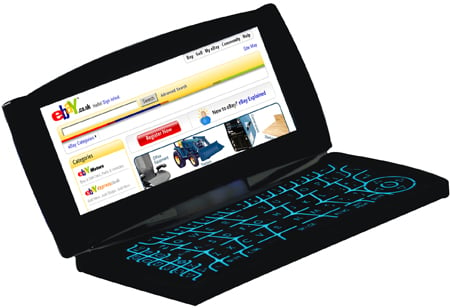
Datawind's PocketSurfer 2: eBay on the move?
First, the hardware. The PocketSurfer 2 is a slim 174g clamshell device not unlike a Nokia Communicator. Clad in shiny black plastic - perfect for presenting fingerprints, alas - with a chrome-like hinge, the device measures 15.2 x 7.5 x 1.5cm when closed.
Opening it reveals the (weakly) backlit 640 x 420 display and a flat QWERTY keypad that's not touch-sensitive but simply mounted above an array of contacts. While that's not a problem when it comes to entering website addresses, it does make navigating around the page more clumsy than it could be. More of which later.
The unit accesses the cellular network directly over a GPRS link, and here the PocketSurfer 2's hardware starts to blend into Datawind's service. First, the network. We understand Datawind's working through Orange, but it's operating as a virtual network so the user has no direct connection to the carrier. If Datawind can get a better deal from, say, O2, it'll shift accordingly and the PocketSurfer 2 users need be none the wiser. The gadget's SIM is embedded right inside the handheld, so it can't be removed, Datawind said.
When it goes on sale in the UK in early August, the PocketSurfer 2 will retail for £180. That includes 20 hours a month's surfing free of charge. Bust the limit and you'll be allowed to surf no more until the following month unless you avail yourself of Datawind's £6-a-month unlimited access package, 'fair use' policy attached.
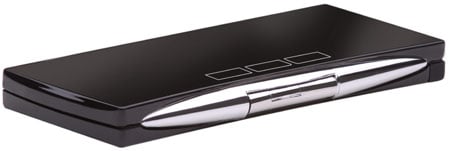
Datawind's PocketSurfer 2: slimline surfing
So yes, once you've coughed up for the hardware, surfing comes for free in the first year, provided you stay within the 20-hour limit. In year two, Datawind will expect a further one-off payment, though as yet it can't say how much that will be. No more than £40, it promised, hinting at the potential to go lower if it makes sufficient money from sponsored links - it's other key revenue source - and signs up plenty of punters.
Datawind also promises the PocketSurfer 2 delivers a "real, desktop web experience", which might sound impossible when you consider the size of the device and that it connects via GPRS. GPRS was chosen because it's cheaper and less power-hungry than 3G, and it's miniscule bandwidth is rendered - Datawind claims - irrelevant by its server technology.
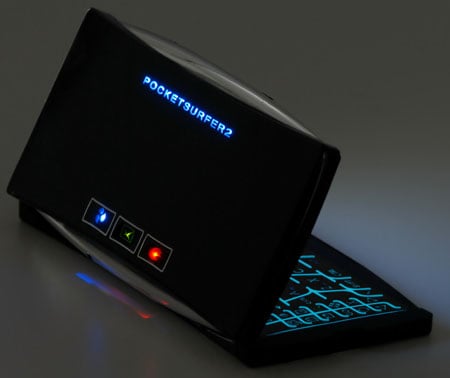
Datawind's PocketSurfer 2: where do you want to glow today?
Essentially, any website viewed on the PocketSurfer 2 is first stored on Datawind's server then crunched to allow as little data as possible to be send over to the device. That makes it fast and keeps Datawind's data costs down, making for a cost-saving it passes on to the buyer in the form of the 'free' web access.
Of course, that makes it cheap, but it also means the device has no life beyond Datawind UK. The company will allow you to roam with it, but that costs extra and last night it wasn't saying how much roaming will cost.
So how well does the PocketSurfer 2 perform?
Ahead of a full review, coming in due course, we give the PocketSurfer 2 a quick spin. Page loading speeds depend largely on what Datawind's server has cached. Sites the company has been demo'ing, like the BBC, the Financial Times, Google and so on are indeed very fast - much quicker than we've seen on other GPRS-connected handhelds. Sites loaded for the first time, such as our own, aren't so rapid and, we found, presented highly-dithered images.
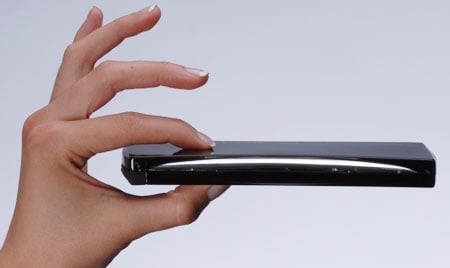
Datawind's PocketSurfer 2: skinny
In part, that's due to the PocketSurfer's screen-quality, which isn't the best we've seen by a very long chalk. Its brightness and contrast are adjustable, but it lacks verve - the colours are pale, the backlight weedy. But it's also the transmission process. That said, some of the images did refresh later with better quality versions, suggesting Datawind sends out better pictures once the page has loaded.
The display's 640-pixel with is a limitation given that most websites are now designed for 800-pixel screens and many take 1024 as the minimum. The PocketSurfer initially presents a window onto the larger page, but it also lets you zoom in and out to see the page as a whole. The issue here is speed, but it's perhaps no slower at this than many other handhelds.
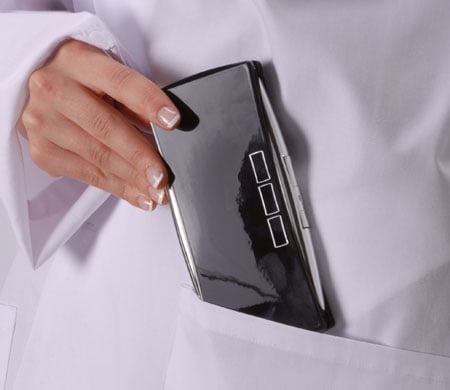
Datawind's PocketSurfer 2: eminently pocketable
Datawind said its browser can handle all the key webpage components - ActiveX, Flash, PDF, Java, JavaScript, SSL security and so on - and HTML elements like frames, and while we didn't have an opportunity to try all these out last night, we can confirm some of them do work and work well.
That said, Datawind admits the PocketSurfer 2 is "not appropriate for audio, video and fast gaming applications", so calling up YouTube may prove disappointing. Again, we look forward to trying this out in the full review.
As we noted earlier, page navigation isn't a smooth as we'd like. There's the usual pointer cursor, steered using four arrow keys arranged in a circle on the bottom right-hand side of the keypad. Pushing and holding a key scrolls the cursor in the appropriate direction, but it's uncomfortable and there's an inevitable 'up a bit, down a bit, up a bit' as you struggle to position the cursor over a link you want to click - none of which highlight when the cursor hovers over them, again making positioning harder than it need be.
Roll on the PocketSurfer 3, then, with either a BlackBerry Pearl-style trackball, a trackpad or a ThinkPad-esque joystick.
We should point out that the PocketSurfer 2 we looked at, like the handful of others on display last night, had the feel of pre-production units, and we hope the hardware construction and materials have been improved for sale.
Despite some glowing coloured logos on the lid, the PocketSurfer 2's only other adornment is a mini USB port used to recharge the built-in battery. Fully charged, the device can surf for five hours flat, Datawind claimed.
It also said the unit has a GPS receiver, though this wasn't a feature the company demo'd and we didn't have the time to investigate. It has no other features - it's not a PDA, for instance, though it can access online mail, contacts and calendaring services if you want this kind of functionality.
Verdict
If Datawind can improve the screen, keyboard and physical make-up of the PocketSurfer 2 then it will have an impressive gadget on its hands. It will have an offering that's excellent value given how pricey surfing can be on a mobile. The PocketSurfer 2 doesn't do voice, so it's not going to replace your phone entirely - indeed, Datawind isn't trying to do so - but for a lot of folk it may well be very tempting as a way of keeping up with Facebook and MySpace on the move.